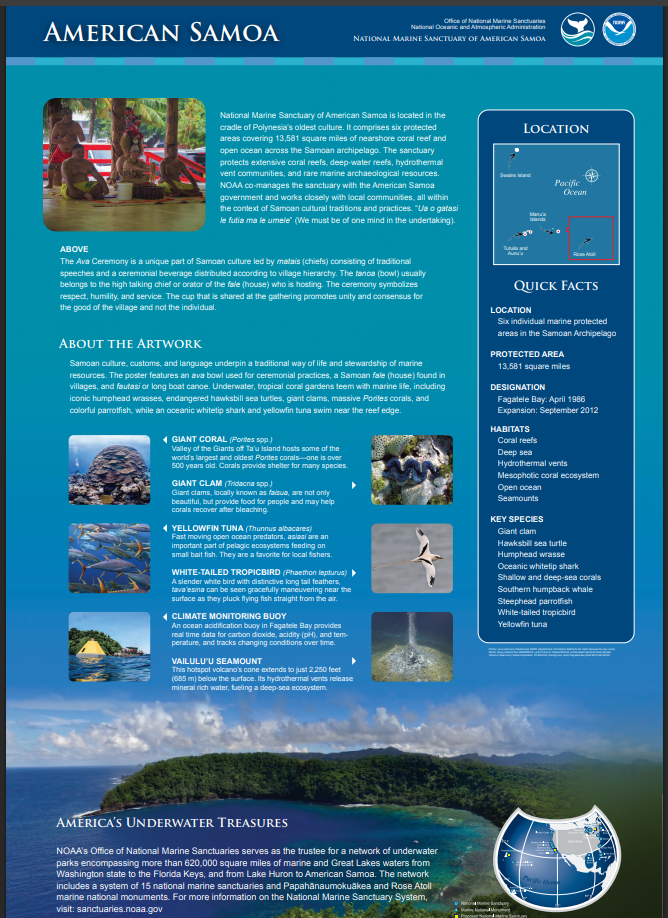Citizen Science and Conservation in American Samoa
- Larissa Clark
- Aug 2
- 3 min read
As we sail further into the Pacific aboard Freeranger, our next upcoming stop is American Samoa - a place where traditional stewardship and modern science seem to intersect.
The National Marine Sanctuary of American Samoa represents one of the most biodiverse marine protected areas in the U.S. characterised by ancient coral, rich fish diversity, humpback whales, endangered hawksbill sea turtles, giant clams and rare seabirds. The sanctuary safeguards vast coral reef systems—home to some of the planet’s oldest and largest Porites coral formations—alongside deep-sea reefs, hydrothermal vent ecosystems, and unique underwater archaeological sites.
Ahead of arrival we've been learning how community participation isn't just encouraged—it’s essential to caring for the reefs, forests, and oceans that support island life.
It will be exciting to see how this region blends cultural heritage with action-driven conservation. Here are some of the initiatives we found interesting to learn more about.
🌿 Community-led Marine Protection: Village Marine Protected Areas (VMPAs)
Since 2000, American Samoa's Community-Based Fisheries Program (CFMP) has empowered villages like Fagamalo and Masausi to design and enforce their own marine protection policies. These Village Marine Protected Areas (VMPAs) now cover around 25% of the territory’s coral reef area (learn more here). These efforts are rooted in community culture and enforceable through local authority and government support as of 2008 (learn more here).
🐠 Coral & Water-Quality Monitoring: Training Local Citizen Scientists
The National Coral Reef Monitoring Program (NCRMP), managed by NOAA’s Coral Reef Conservation Program, works closely with the Department of Marine and Wildlife Resources (DMWR) and the Coral Reef Advisory Group (CRAG). Together, they've trained local residents—fisherfolk, students, tourism guides—to conduct snorkeling surveys, water sampling, and reef health assessments using standardized protocols like the Rapid Ecological Assessment method (learn more here). Capacity-building in this way ensures scientific skills are held locally and data collected informs reef management and restoration plans.
🤖 Education & Outreach: Inspiring Youth Through STEM and Citizen Projects
The National Marine Sanctuary of American Samoa has run a range of educational outreach programs, including “Sanctuary Summer Science in the Village”, ROV-building workshops, and underwater robotics competitions for high schoolers in the past (more here). Camps and ongoing programs at the Tauese P.F. Sunia Ocean Center (which sadly looks to be temporarily closed for renovations until August 2025 - maybe we'll get lucky and it'll open while we are there!) help bridge traditional culture with marine science and hands-on experience for young islanders.
✅ Why This Matters: The Power of Citizen Science
Theme | Description |
Local Ownership | Data collection and sanctuary designation are driven by village communities. |
Capacity Building | Training potable to empower local scientists ensures longevity of projects. |
Youth Connections | Education, STEM, and hands-on experiences build the next generation of stewards. |
Policy Support | Data guides coral reef legislation, fisheries management, and public awareness. |
📍 Next Stop: American Samoa
At Free Range Ocean, we try to fuel our voyage aboard Freeranger by curiosity, storytelling, and meaningful engagement. Although we only expect to be in American Samoa for a few days we look forward to:
Learning more and participating in reef monitoring or water sampling efforts where invited
Support and share the work of local conservation leaders
Document and broadcast what we learn aboard Freeranger
Promote involvement via our Citizen Science Directory
We’re arriving with open minds, notebooks ready, and a mindset aligned with the guardians of these islands. If you or your community in American Samoa are engaging in conservation or citizen science, we’d love to connect.
Reach out via our Instagram [@freerangeocean] or email hello@freerangeocean.org
Until landfall—fair winds and purposeful sails!
🌏🌊 Larissa, Duncan, Eden and Skye
---
p.s. We love the NOAA poster below which features an ava bowl used for ceremonial practices, a Samoan fale (house) found in villages, and fautasi or long boat canoe. Underwater, tropical coral gardens teem with marine life, including iconic humphead wrasses, endangered hawksbill sea turtles, giant clams, massive Porites corals, and colorful parrotfish, while an oceanic whitetip shark and yellowfin tuna swim near the reef edge. Illustration by Matt McIntosh/NOAA

References
Community-Based Fisheries Program and VMPAs: https://en.wikipedia.org/wiki/Masausi%2C_American_Samoa & https://en.wikipedia.org/wiki/Fagamalo%2C_American_Samoa
NOAA Reef Monitoring Program training: https://coralreef.noaa.gov/aboutcrcp/news/featuredstories/mar25/amersamoa-wq.html
NCRMP Socioeconomic monitoring details: https://www.coris.noaa.gov/monitoring/socioeconomic_AS.html
Sanctuary education & ROV programs: https://sanctuaries.noaa.gov/news/jan20/2019-education-outreach-highlights.html
ASCC QUEST programme: https://www.crag.as/education-outreach
National Marine Sanctuary of American Samoa: https://en.wikipedia.org/wiki/National_Marine_Sanctuary_of_American_Samoa
Rose Atoll biodiversity details: https://en.wikipedia.org/wiki/Rose_Atoll
National Park of American Samoa: https://en.wikipedia.org/wiki/National_Park_of_American_Samoa




Comments